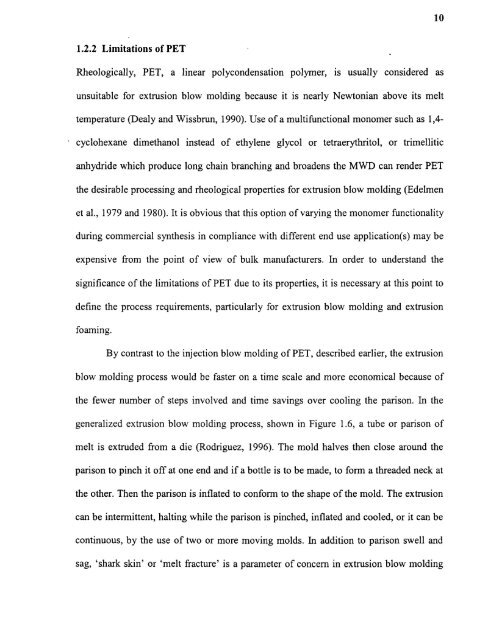A reactive melt modification of polyethylene terephthalate
A reactive melt modification of polyethylene terephthalate
A reactive melt modification of polyethylene terephthalate
You also want an ePaper? Increase the reach of your titles
YUMPU automatically turns print PDFs into web optimized ePapers that Google loves.
10<br />
1.2.2 Limitations <strong>of</strong> PET<br />
Rheologically, PET, a linear polycondensation polymer, is usually considered as<br />
unsuitable for extrusion blow molding because it is nearly Newtonian above its <strong>melt</strong><br />
temperature (Dealy and Wissbrun, 1990). Use <strong>of</strong> a multifunctional monomer such as 1,4-<br />
cyclohexane dimethanol instead <strong>of</strong> ethylene glycol or tetraerythritol, or trimellitic<br />
anhydride which produce long chain branching and broadens the MWD can render PET<br />
the desirable processing and rheological properties for extrusion blow molding (Edelmen<br />
et a1., 1979 and 1980). It is obvious that this option <strong>of</strong> varying the monomer functionality<br />
during commercial synthesis in compliance with different end use application(s) may be<br />
expensive from the point <strong>of</strong> view <strong>of</strong> bulk manufacturers. In order to understand the<br />
significance <strong>of</strong> the limitations <strong>of</strong> PET due to its properties, it is necessary at this point to<br />
define the process requirements, particularly for extrusion blow molding and extrusion<br />
foaming.<br />
By contrast to the injection blow molding <strong>of</strong> PET, described earlier, the extrusion<br />
blow molding process would be faster on a time scale and more economical because <strong>of</strong><br />
the fewer number <strong>of</strong> steps involved and time savings over cooling the parison. In the<br />
generalized extrusion blow molding process, shown in Figure 1.6, a tube or parison <strong>of</strong><br />
<strong>melt</strong> is extruded from a die (Rodriguez, 1996). The mold halves then close around the<br />
parison to pinch it <strong>of</strong>f at one end and if a bottle is to be made, to form a threaded neck at<br />
the other. Then the parison is inflated to conform to the shape <strong>of</strong> the mold. The extrusion<br />
can be intermittent, halting while the parison is pinched, inflated and cooled, or it can be<br />
continuous, by the use <strong>of</strong> two or more moving molds. In addition to parison swell and<br />
sag, 'shark skin' or '<strong>melt</strong> fracture' is a parameter <strong>of</strong> concern in extrusion blow molding

















